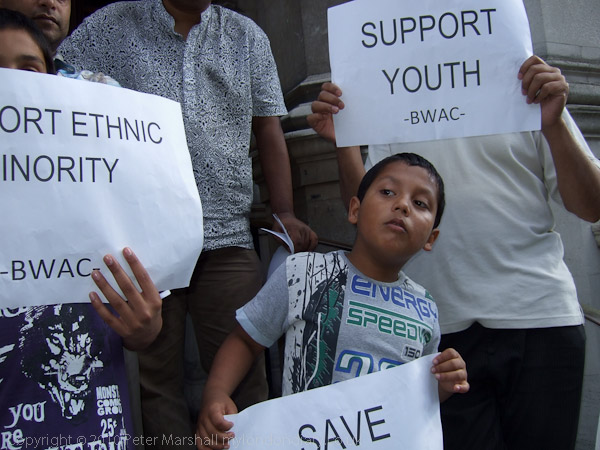I hadn’t actually gone to Croydon to photograph a demonstration but to pick up some my pictures that had been at a show in the library there. But the library is next to the town hall in one of those fine Victorian municipal complexes (though perhaps not as fine as that in my own home town, replaced by a featureless shopping centre in the 1970s) and there were around 50 people protesting on the town hall steps.

Unusually, and because I had half a dozen framed pictures to carry home, I hadn’t taken a ‘proper’ camera with me, but I did have my small Fuji F31fd compact in my pocket, so I went across and took a few pictures, some of which you can see on My London Diary, where I also have written more about this protest over the withdrawal of grants to many local voluntary groups including the BWAC – something we will see happening across the country.
Of course at the scale reproduced here, apart from the squarer aspect ratio it is hard to tell the difference between this image and what I might have taken using my normal Nikon. What did surprise me was how little difference there is between this image and those when looked at much larger on screen.
Part of the reason for this is that instead of using the jpeg image straight from the Fuji camera I imported it into Lightroom, and worked on it in much the same way as I would have done with a RAW image from the Nikon, using some noise reduction, altering contrast and exposure, burning in some of the highlight areas and opening up the shadows.
There are differences, with a little kind of blue haze around some of the edges that Lightroom can’t remove, and the image is only 6Mp rather than the 12Mp from the Nikons. But overall the result is pretty good, and would certainly hold up well for an A4 full page reproduction.
Perhaps the biggest difference was in taking the pictures, both in how I could work and in the reactions of the people I was photographing. There were two guys from the local press also taking pictures at the same time using the same kind of gear as I would normally have, and they were getting rather more attention and cooperation from the protesters than I did. It wasn’t a problem as I generally like to work in a more informal way than the local press, but there was a noticeable difference in the interaction.
But I also felt that I was working more or less blind, holding out the camera in front of me and peering at an almost invisible image on the camera back in front of me and had very little idea exactly where the edges of the image would be. After taking the pictures it was possible to see a little better by holding my hand around the screen, but I couldn’t really tell if the pictures were sharp or see them well.
It wasn’t a very visual event, with only a handful of placards and nothing much happening, and I had other things to do so was unable to stay long and see if anything developed. It served to remind me why I find it worthwhile to carry a couple of relatively heavy cameras and a bag with extra lenses rather than a camera that would slip in a pocket – even though the quality of the results – with some help from Lightroom – was a pleasant surprise.
Working with jpegs in Lightroom requires a few different settings to normal. The main thing to remember is that jpegs have already been subjected to a tone curve in the camera and don’t need your usual one on import. I find the Linear Contrast option gives the best result with my files. Again your normal import sharpening is unlikely to be needed as the jpeg will already have been sharpened (even if you have selected to turn off sharpening in the camera options. The camera will also have applied some noise reduction but it may be possible to do a little more with Lightroom without losing image detail.
Camera settings are of course also vital. If you are working with a compact and want high quality results you need to make sure you use the lowest possible ISO setting for the lighting conditions as well as highest quality jpeg setting (called Fine on some cameras) and also a large enough image size – usually the maximum the camera can produce, and certainly at least 6Mp. Other settings such as contrast, sharpening and colour are also important, and you will almost certainly get the best results if you are working with your images in Lightroom if you use the lowest contrast and sharpening settings and also the most neutral colour.